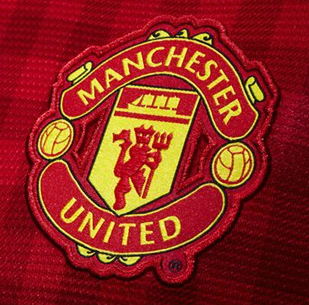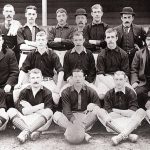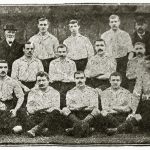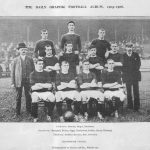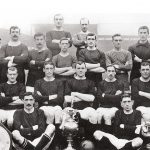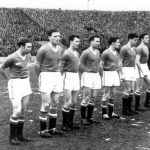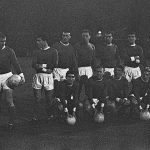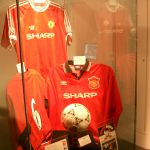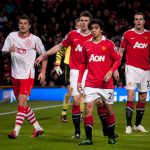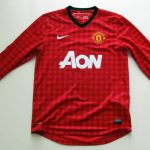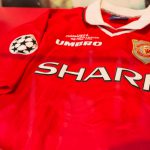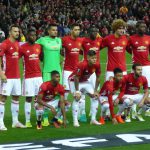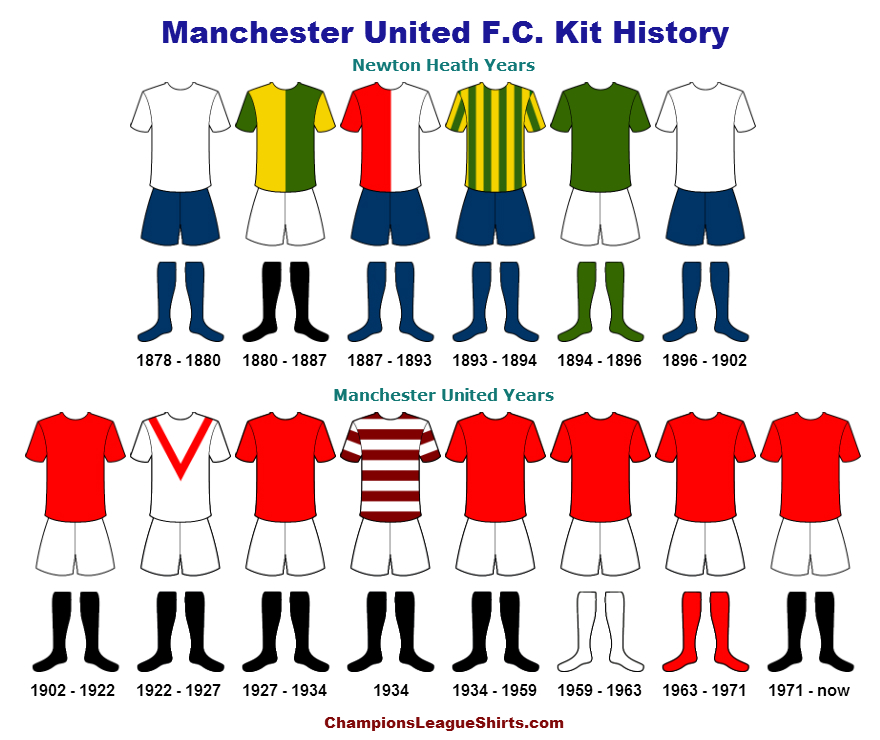Welcome to the Manchester United kit history page. This is the hub for Man U official game apparel, its colours and its visual history. Check the bottom of the page for articles relating to the Red Devils or view the club’s current kit.
The Colours
Manchester United colours are red and white. They have been established in 1902, when the team changed its name from Newton Heath to its current name. Known as the “Red Devils”, the United players currently take the field in red jerseys and black shorts during home games. Those are usually accompanied by red/black socks. For away fixtures this season, Manchester United don light pink shirts and black shorts. The club’s third kit is all navy with gold lettering and is made of recycled ocean plastic.
* CHECK OUT ALL MANCHESTER UNITED F.C. KIT AND GEAR HERE! *
The Badge
The badge of Manchester United is red and yellow. It features a shield with a ship on the top and a red devil on the bottom. The ship is the only remaining symbol from the Manchester coat of arms and it represents the city’s history as a major trading power, while the red devil stems from the club’s nickname and was incorporated into the logo in 1970. The shield is surrounded by the words “Manchester” and “United” on the top and bottom respectively, joined together by two old-style footballs. The logo can be seen on the team jerseys and at the entrance to their home ground – Old Trafford.
Home Ground: Old Trafford
Nickname: The Red Devils
Motto: We’ll Never Die
Manchester United Kit History
The Home Kit
Newton Heath Years: Manchester United was founded in 1878 by railway workers as Newton Heath LYR (the letters stood for “Lancashire & Yorkshire Railway”). It was a modest team with a small budget that rented their grounds from their patron railway company. Their initial uniforms were white shirts with a blue cord and blue socks and breeches. The shirts were of simple quality, with long sleeves and often repaired several times during the season. The cord was worn over the jersey, but it is unknown in which exact position.
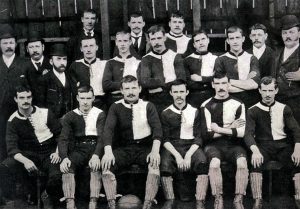
In 1880 or 1881, after some local financial contributions, the club purchased higher quality green and gold jerseys, which were likely made of cashmere and reflected the colours of their patron company. These were “halved” – with green on the left side of the chest and gold on the right side and were paired with white shorts and black socks. They lasted till 1887, when a new red and white design was adopted. Like their predecessors, the new shirts were also “halved” and featured white on the left breast and red on the right one. They were accompanied with blue shorts and socks. Dressed this way, Newton Heath LYR joined the new Football Alliance in 1889 and then as the Alliance was absorbed by the Football League in 1892, the team was given a spot in the first division. It was also that year that the Lancashire & Yorkshire Railway Company imposed increased stadium rent on the club, which forced the club to drop the association with its patron and remove the LYR from its name, remaining simply Newton Heath.
In 1893, Newton Heath was wearing green and gold patterns again, this time in the form of stripes and starting in the 1894 season, it changed its shirts to all green, this time with white shorts and green socks. The jerseys featured yellow trim at first, finally becoming fully monochromatic till in 1896 the final outfit change for Newton Heath occurred and the club settled on white shirts with blue shorts and socks, reflecting the original colours chosen at conception.
Click to enlarge
Manchester United Years: At the beginning of the 20th century, the club was in financial troubles. It was playing in the second division of the Football League and it was served a winding-up order, due to its extensive debts. Four local businessmen saved the club (among them John Henry Davies who became club president), each willing to invest 500 pounds. With renewed faith, the club reinvented itself, changing its name officially to Manchester United. It adopted the colours that the team is now known for – red shirts and white shorts. It paired these with black socks, which were sometimes adorned with blue or striped white trim. Success followed. In 1906, the club was promoted back to the first division and in 1908 and 1911 it became the league champions. In 1909, Manchester United won its first FA Cup and the same year it moved to its new home – Old Trafford.

Very few changes were introduced till 1922, when the club adopted all white uniforms with a red V around the neck. This design had been seen before during the 1909 FA Cup Final and it now returned for good. It was paired with black socks. It lasted merely till the end of 1926-1927 season and then never came back again. Instead, the team went back to the red and white strip of the previous years, which is the iconic look of Manchester United we know today. Since then, the Red Devils have always played in red and white, with the exception of one single year. In 1934, a cherry and white (credited at the time as “maroon and hoop”) horizontally striped shirt – previously used as away kit and considered lucky – made an appearance but survived only till the end of that year. The team registered its lowest placement in the club’s history (20th in the second division), loosing confidence in the outfit change and recalling it.
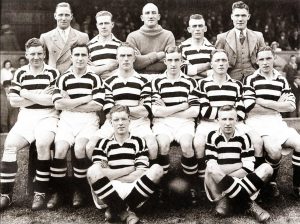
After that, Manchester United never veered again from its iconic red and white colours. The only modification was done to the socks, which over the years featured various changes to their trim, ranging between red and white or just plain red. In 1959, the socks turned white, while in 1963 they became red. They reverted to black in 1971 and to this day they remain this colour. The team does however, wear black shorts and white socks on occasion when there is a clash with the opponents’ uniforms and since 1997 it prefers white socks for its European games. Its most famous historical sides – the Busby Babes of the 50s, the Bobby Charlton, Denis Law and George Best of the 60s United, as well as the glory teams of Alex Ferguson – have always been seen wearing a red shirt of Manchester and the colour is now synonymous with the brand. To see the club’s current kit, click here.
Click to enlarge
The Sponsorship
In 1982, the era of shirt sponsorship begun and Manchester United started wearing the logo of the Japanese electronics giant Sharp. In 200, the British multinational telecommunications company Vodafone replaced Sharp and six years later in 2006 the Man Utd shirts bore the logo of AIG – the American Insurance Company. Aon took over as the sponsor in 2010 and finally in 2014 a lucrative deal with the US car maker Chevrolet was reached, adding the yellow touch of the Chevy logo to the Manchester United shirt. Likewise, the shirts of the team in the 60s were made by Umbro, replaced by Admiral in 1975 and then Adidas in 1980. Umbro returned in 1992, when the visuals of football fashion became bold and patterned and the club’s jerseys were often augmented by elaborate trim – yet still more subdued than most teams of that era. Finally, in 2002 Nike took over as the club’s kit manufacturer eventually giving way to Adidas in 2015.
The Away Kit
The first mention of Manchester United away kit is believed to be from around 1888, when known as Newton Heath the club split from its railway patron and adopted new home strip. It is mentioned that following that decision, the team used their old gold and green jerseys as they away kit. Those seem to be the first away colours of the club and while periodic mentions of other types of jerseys have been found, it’s unclear whether those were in any form official or simply worn on some occasions.
It wasn’t till 1902, when the club officially became Manchester United, that the records get more clear. Having already chosen their famous red and white for home games, the away strip of the club was striped in white and green. The stripes were vertical and matched with dark shorts and socks. The latter two are believed to had been black, but the black and white photographs of the era make the distinction difficult. White shorts have also been worn and the team seemed to change between the black and white bottoms depending on need. In 1907, the away strip turned all white and in 1910 the stripes returned, this time in blue and white.

Successful in the first decade of 1900s, Manchester United encountered a slump shortly after and wasn’t able to turn its fortunes. The team was once again playing in the second division and needed a boost. To inspire it, the club adopted white v-patterned uniforms as their home strip and relegated their red shirts and white shorts that the Red Devils are now famous for to their away strips. This move did little to lift the club fortunes and in 1932 a new shirt was designed. This one – once again – had stripes, but this time horizontal ones. They were maroon and white and were initially paired with white shorts and black socks. A few high profile away wins followed and the new striped kit became a symbol of luck. To capitalize on it, the administrators of Manchester United reversed the team kits in 1934 – substituting the home strip for the striped one and relegating the full red shirts to away games. Yet here luck failed and the team was unable to capitalize on fortune. At the end of the year, the change was unmade and the horizontal maroon and white hooped shirt once again returned as the away jersey. It lasted this way till the beginning of World War II in 1939.
During the war years and for over a decade later, Manchester United had blue shirts and white shorts as their away uniforms. The socks were initially black during the war, striped right after, eventually changing to black once again. In the early 50s, the team experienced its first golden age. A young squad under the management of Matt Busby, it regularly played in the first division and placed as the runners up of the Football League four out of five times, before finally winning it in 1952. It repeated the feat in 1956 and 1957 and entered its first European Cup, against the wishes of the League. It was that year, in 1957 that Manchester United did away with their blue shirts and adopted an all white kit (from head to toe) for their away games.

In the late 50s and the 60s, the football kits were getting more modern and comfortable. The all white kit often had red trim, sometimes at the collar, sometimes at the sides of the shorts or the top of the socks. It lasted till 1975, although on occasion the blue shirts made an appearance for select games… most notable of those being the first European Cup win in 1968. In 1975, the white jerseys received three vertical stripes on the left side (a later point of contention with Adidas) and were combined with black shorts and socks. They retained that look till 1982, when the Adidas took over as the shirt sponsor. The company made only slight adjustments to the uniforms of the Red Devils, moving the stripes to the sleeves and changing the socks to white.
The 1990s introduced an era of bold visual patterns in football fashion. While Manchester United got through it relatively unscathed compared to many other European and national sides, they were not immune to visual experimentation. Starting in 1990, the away uniforms of the Old Trafford team begun varying greatly from season to season, both in design and often in colour. The prevailing colours were usually blue, black and white, with the exception of five games of the 1995-1996 season, when an all gray strip was adopted and dropped almost immediately, as it reportedly made it difficult for the players to pass to each other, as claimed by Alex Ferguson’s men. The most notable ensembles of this era were the striking …. blue and white shirt used in the famous 1992 FA Cup win (used from 1990 to 1992) and the all black kit used between 1993 and 1995, the first black strip used after the Premier League reversed its prohibition of using black shirts.
Click to enlarge
The trend of using the blue, black or white for their away colours continues to this day. Compared to many other professional football clubs, Manchester United usually keep minimalist trim on their uniforms. Their current second kit is fully black again, with white Adidas stripes running down its sides.
Manchester United Badge History

These days, the famous red and yellow insignia featuring a red devil is known around the globe, but Manchester United hasn’t always had a fully defined crest. Having started their existence as Newton Heath LYR, the team didn’t display any logos on their shirts and it’s likely that it had no logo at all. If anything, it was identified by the crest of its parent company – Newton Heath Railway – as it played its first seasons against other railyard sides in a local league. When the club changed its name to Manchester United, it adopted the red and white colours for its kit, but no crest emerged. In 1909 FA final, the team wore a badge with a red rose on its jersey and this started a United tradition of displaying a badge for Cup finals games. Much like the other English teams of the era however, the Old Trafford boys didn’t display a logo during regular league games.
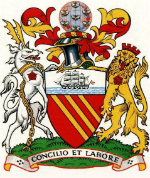
In 1957 FA Cup final against Aston Villa at Wembley, which United won 2-1, the team wore the Manchester City Council court of arms on their chests and that is widely considered to be their first crest. On 6th of February 1958, on the way back from a European Cup tie against Red Star Belgrade, the team’s plane crashed at Munich airport, killing seven of the first team players and twenty two people in total. Those were the years of the Busby Babes, when under the brilliant leadership of Matt Busby a team of youngsters was earning silverware in the Football League and turning heads in a European competition. That year, during the FA Cup final against Bolton Wanderers, United wore another crest, often incorrectly believed to represent a phoenix rising from the ashes, in reference to the re-emerging club spirit after the tragedy. In fact, the image was that of a golden eagle which was featured in the new Manchester court of arms. The eagle could also be seen recently as part of Manchester City last badge.
In 1968, a version of Manchester court of arms appeared again on the United’s shirts in the famous European Cup final against Eusebio led Benfica, which occurred ten years after the Munich crash and which the Red Devils won 4-1. This version had the letters E.C.F. stitched over the logo. Meanwhile, at some point in the 1960s the first version of the modern logo appeared. It was red and white and had the words “Manchester United Football Club” written in large letters, separated by two white roses. Between them was a shield featuring a motif from the city’s coat of arms (with three slashes for three rivers crossing the city) and a ship, representing Manchester as the major trading power. Interestingly, the roses were white – instead of Lancashire red – and the logo never appeared on the shirts, only in official documents.

At some point during the 60s, the team coined the moniker “Red Devils”, believed to come from a French journalist. The nickname stuck and in early 1970s, the three slashes were replaced by an actual red devil and the United crest was redesigned once more. The roses gave way to footballs, the background turned white and the top of the logo became more round. In the 1972-1973 season, the logo finally made it to the team’s football shirts permanently. It went through several cosmetic changes in the next two decades, with the ship turning red and boots added on each side of the crest’s upper half. This change was done by Admiral, which was the shirt manufacturer at the time, with additional three stripes added to the boots when Adidas took over next.
In 1992, Umbro emerged as the kit manufacturer and made slight changes to the logo. The background turned red and the boots were removed. In 1993, the white lettering and the ship both turned gold. Finally, in 1998 the final version of the logo was produced. This one saw the words “Football Club” dropped, to make Manchester United a more marketable brand. The ship received a red background and the proportions were altered slightly. This version of the logo is one of the most recognizable symbols in football today and worn by United fans all over the world.
Manchester United Kit History – ChampionsLeagueShirts.com
Image sources: 1, 2, 3, 4, 5, 6, 7, 8, 9, 10, 11, 12, 13, 14, 15, 16, 17, 18, 19, 20, 21, 22, 23, 24, 25
RELATED POSTS
 Keep Calm Love Man Utd – the Shirt Lives On!- "Keep calm love Man Utd, everyone" is the message being sent from one of the greatest clubs in the world. No need to panic. While life may have been frustrating after the departure of Alex Ferguson, things haven't exactly been all that bad. Manchester United is still one of the best clubs in England and is worshiped all over the… [...]
Keep Calm Love Man Utd – the Shirt Lives On!- "Keep calm love Man Utd, everyone" is the message being sent from one of the greatest clubs in the world. No need to panic. While life may have been frustrating after the departure of Alex Ferguson, things haven't exactly been all that bad. Manchester United is still one of the best clubs in England and is worshiped all over the… [...]

